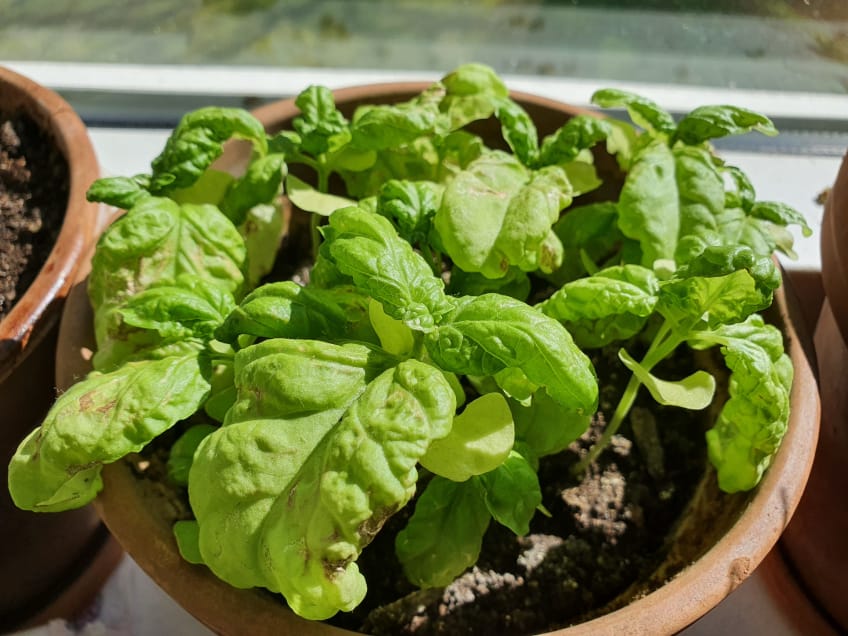One of my favorite things about growing basil is that there are so many different varieties. Some of the varieties have huge leaves that can grow as large as the palm of a hand.
There are several basil varieties that grow large leaves. Some varieties produce leaves that get as large as up to 6 inches (15 cm) in length.
Below, I have described the five basil varieties that grow the largest leaves. I have arranged them so that the varieties with the largest leaves are at the top.

The 5 Basil Varieties With the Largest Leaves
One of the coolest things about basil is how different the many varieties are. If you are interested in learning about the varieties that produce the largest leaves, such as my (slightly damaged) Italian Large leaf basil in the photo above, you have come to the right place.
If you are interested in how large different basil varieties and their leaves get, check out this post where I cover 22 different varieties. For the ones with the largest leaves, stay right here.
Green Ruffles Basil
Green ruffles is an annual herb and a variety of Lettuce leaf basil. Lettuce leaf basil varieties grow some of the largest leaves of all basil varieties.
| Leaf size | Plant height |
| 4-6 inches (10-15 centimeters) | Up to 24 inches (Up to 60 centimeters) |
As a member of the Lettuce leaf variety, the leaves from Green ruffles pesto look very similar to green lettuce leaves. They are large and ruffled and have an oval shape and a light green color.
The leaves from Green ruffles basil taste a bit milder than many other basil varieties. They work very well in salads or as a decorative green garnish for many dishes. Other than that, Green ruffles basil leaves work well in almost anything where basil is good such as pasta dishes and green pesto.
The Green ruffles basil plant is larger than most other basil varieties, including popular varieties such as Thai and Lemon basil. The most common basil variety, Genovese basil, can grow larger, but the leaves on Green ruffles basil still become larger than those from the Genovese variety.
Napoletano Basil
Napoletano basil is an annual herb and a variety of Sweet basil.
| Leaf size | Plant height |
| Up to 5 inches (12.5 centimeters) | 18-24 inches (45-60 centimeters) |
Napoletano basil is often called lettuce leaf basil or large leaf basil because of its large, light green leaves. The leaves are oval-shaped and ruffled and look very similar to leaves from regular green lettuce.
The Napoletano basil plants can grow quite large. They can reach heights of up to two feet, so as with most other basil varieties with large leaves, the plant itself is also quite large.
Like Green ruffles basil or Genovese basil, Napoletano basil can be used in almost any dish but is especially good in soups, sauces, pasta, and fish dishes.
Italian Large Leaf Basil
Italian large leaf basil is from the Sweet basil variety. It is an annual basil variety that will sprout, grow, and flower within one growing season.
| Leaf size | Plant height |
| Up to 4 inches (10 centimeters) | 24-30 inches (60-75 centimeters) |
Italian large leaf basil is probably the most well-known large leaf basil variety.
The Italian large leaf basil leaves are oval but more rounded than Lemon basil or Lime basil, which have more pointy leaves.
When the leaves are new and young, they are light green but quickly get darker and get a smooth and shiny surface.
Italian large leaf basil is full of oils, giving off a strong aroma and flavor, so it is a pretty efficient herb to grow since you don’t need as many leaves when cooking as you would with many other basil varieties.
Compared to the more commonly known Genovese basil, Italian large leaf basil is similar but a bit sweeter. Therefore, it works exceptionally well in pesto and pasta dishes.
Mammoth Basil
Mammoth basil is an annual herb and a member of the Lettuce leaf basil variety.
| Leaf size | Plant height |
| Up to 4 inches (10 centimeters) | Up to 16 inches (40 centimeters) |
Mammoth basil has large ruffled leaves that are oval-shaped but pointy at the end.
The flavor of Mammoth basil is very similar to the taste of the well-known and common Genovese basil but can often be a bit stronger and not as sweet.
Mammoth basil seems to be very popular among Italian chefs because the shape and size of the leaves make them great for wrapping around food. They also work great in pesto or when you use whole leaves in salads or on sandwiches.
Siam Queen Basil
Siam queen basil is a Thai-basil variety. It is an annual in most parts of the world but can be grown as a perennial in USDA zones above 10 in the US.
| Leaf size | Plant height |
| Up to 4 inches (10 centimeters) | 10-24 inches (25-60 centimeters) |
The leaves from siam queen basil plants look a bit different from most other basil varieties. They are long and narrow, pointy, and arrow-shaped, and have a light green color when they are small and young but turn darker as they mature.
Siam queen basil leaves not only look different but also taste different than most other basil varieties.
As a variety of Thai basil, Siam queen basil leaves have a distinct licorice-like flavor and aroma and are excellent in Asian dishes, but can also work as an exciting addition to many desserts.
Sources
Read My Complete Guide to Growing and Caring for Basil
I have written a thorough guide where I cover all parts of growing your own basil including choosing a variety, sowing the seeds, the best growing conditions, pruning, propagation, harvesting, storing, solving various problems, and a lot more. You can find the article on this link.

